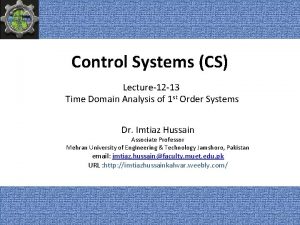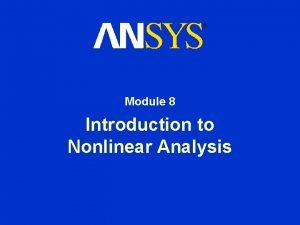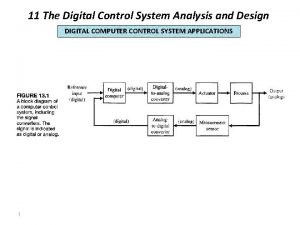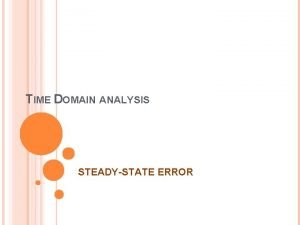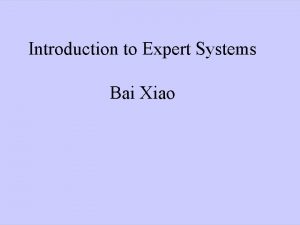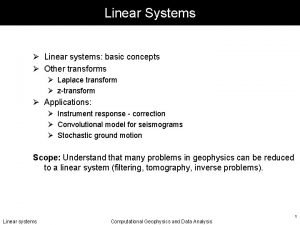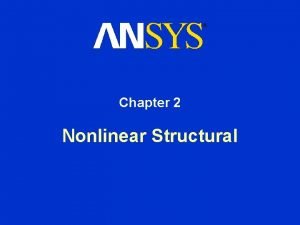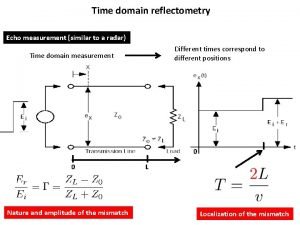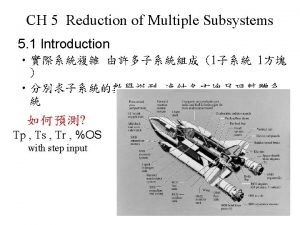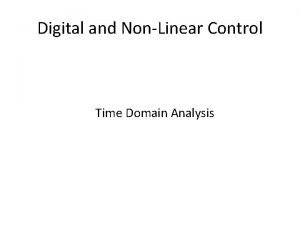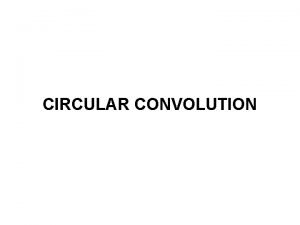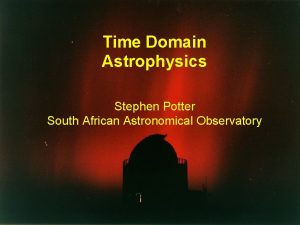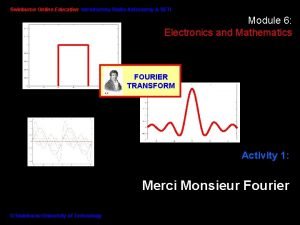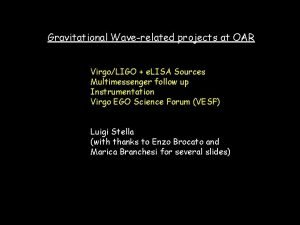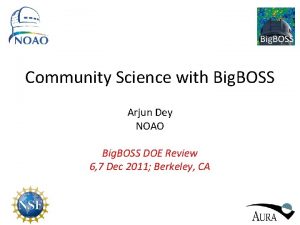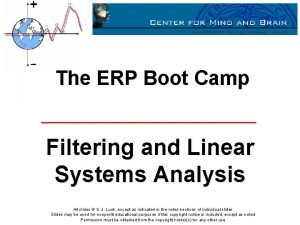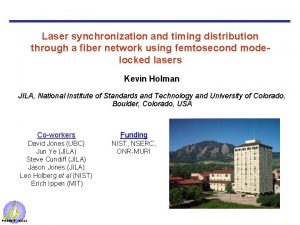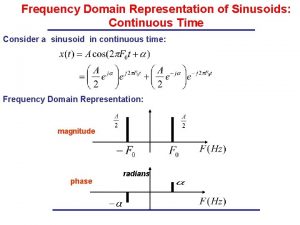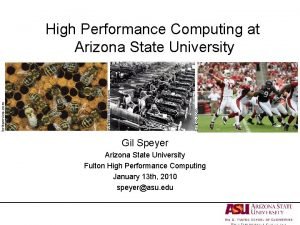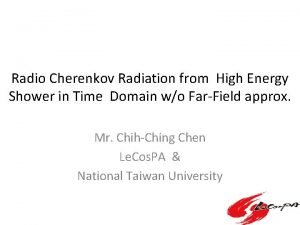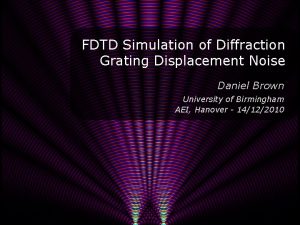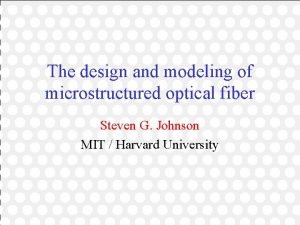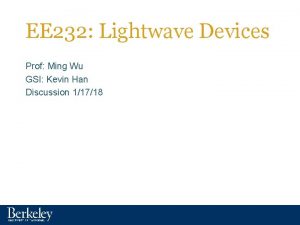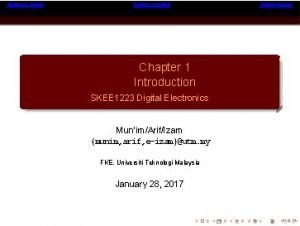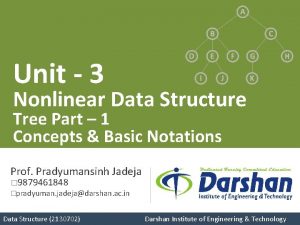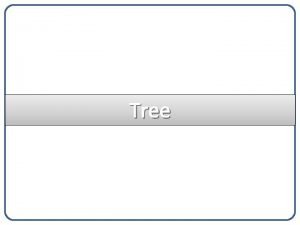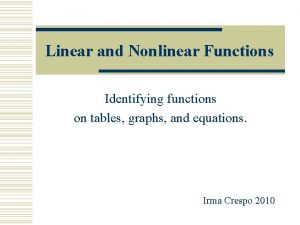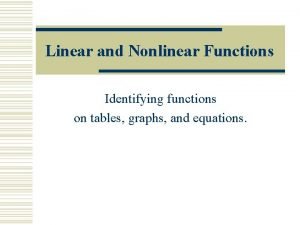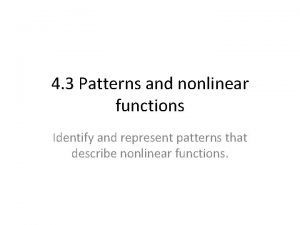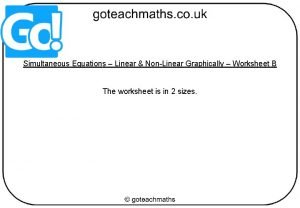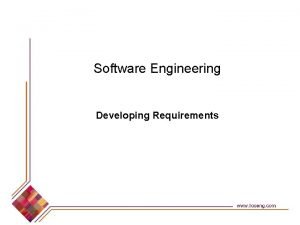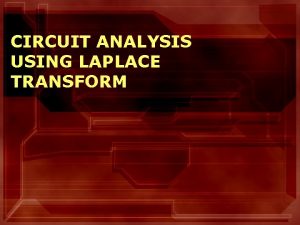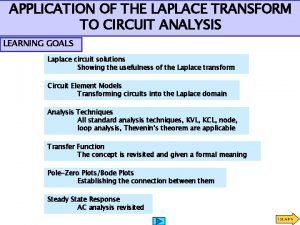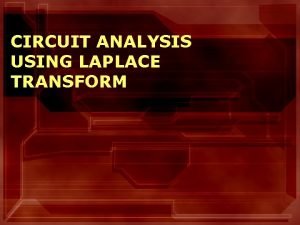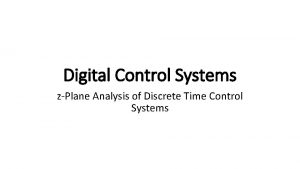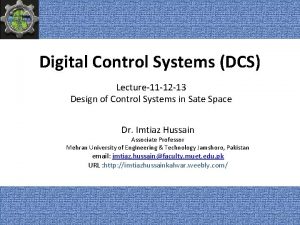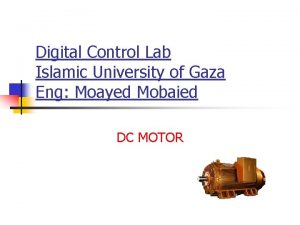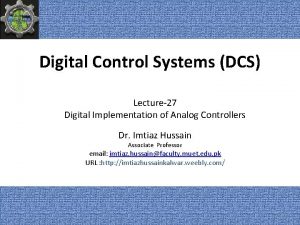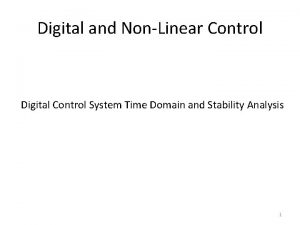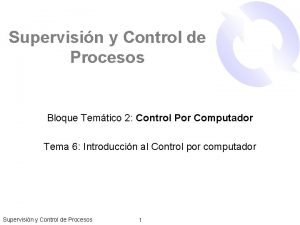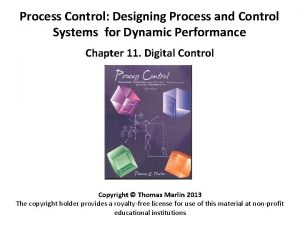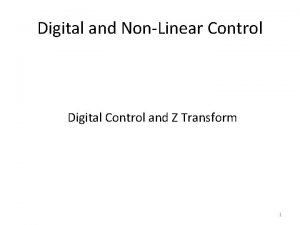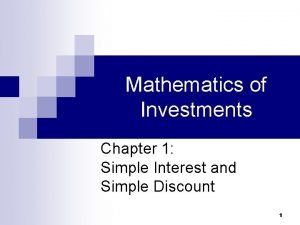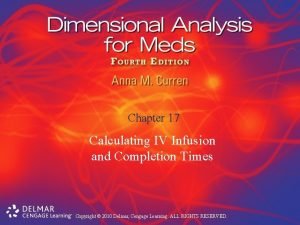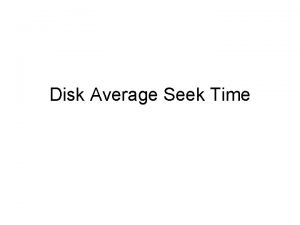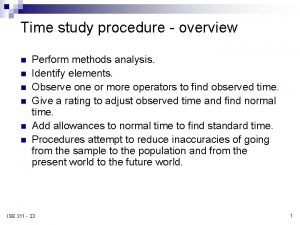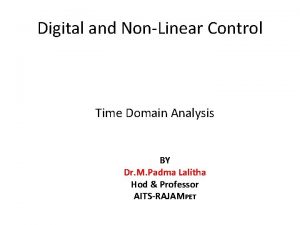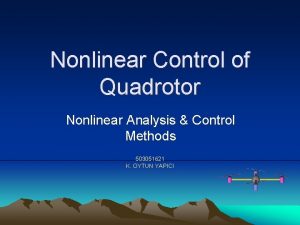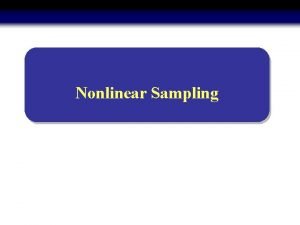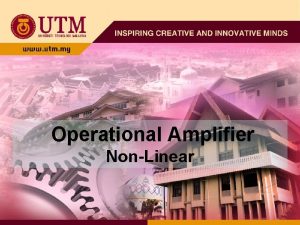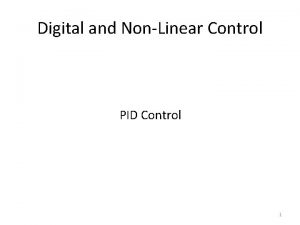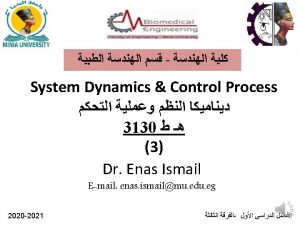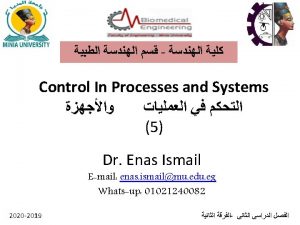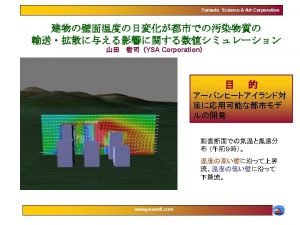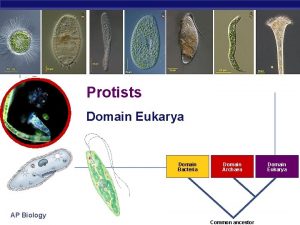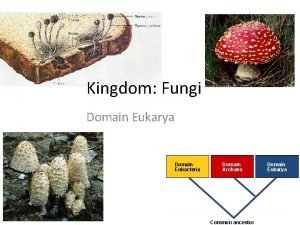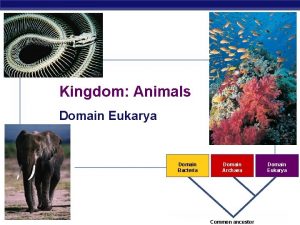Digital and NonLinear Control Time Domain Analysis Introduction























































































- Slides: 87

Digital and Non-Linear Control Time Domain Analysis

Introduction • In time-domain analysis the response of a dynamic system to an input is expressed as a function of time. • It is possible to compute the time response of a system if the nature of input and the mathematical model of the system are known. • Usually, the input signals to control systems are not known fully ahead of time. • It is therefore difficult to express the actual input signals mathematically by simple equations.

Standard Test Signals • The characteristics of actual input signals are a sudden shock, a sudden change, a constant velocity, and constant acceleration. • The dynamic behavior of a system is therefore judged and compared under application of standard test signals – an impulse, a step, a constant velocity, and constant acceleration. • The other standard signal of great importance is a sinusoidal signal.

Standard Test Signals • Impulse signal – The impulse signal imitate the sudden shock characteristic of actual input signal. δ(t) A 0 – If A=1, the impulse signal is called unit impulse signal. t

Standard Test Signals • Step signal – The step signal imitate the sudden change characteristic of actual input signal. u(t) A 0 – If A=1, the step signal is called unit step signal t

Standard Test Signals • Ramp signal – The ramp signal imitate the constant velocity characteristic of actual input signal. r(t) t 0 r(t) ramp signal with slope A – If A=1, the ramp signal is called unit ramp signal r(t) unit ramp signal

Standard Test Signals p(t) • Parabolic signal – The parabolic signal imitate the constant acceleration characteristic of actual input signal. t 0 p(t) parabolic signal with slope A p(t) – If A=1, the parabolic signal is called unit parabolic signal. Unit parabolic signal

Relation between standard Test Signals • Impulse • Step • Ramp • Parabolic

Laplace Transform of Test Signals • Impulse • Step

Laplace Transform of Test Signals • Ramp • Parabolic

Time Response of Control Systems • Time response of a dynamic system response to an input expressed as a function of time. System • The time response of any system has two components • Transient response • Steady-state response.

Time Response of Control Systems • When the response of the system is changed from equilibrium it takes some time to settle down. • The response of the system after the transient response is called steady state response. Transient Response Steady State Response • This is called transient response.

Time Response of Control Systems • Transient response depend upon the system poles only and not on the type of input. • It is therefore sufficient to analyze the transient response using a step input. • The steady-state response depends on system dynamics and the input quantity. • It is then examined using different test signals by final value theorem.

Introduction • The first order system has only one pole. • Where K is the D. C gain and T is the time constant of the system. • Time constant is a measure of how quickly a 1 st order system responds to a unit step input. • D. C Gain of the system is ratio between the input signal and the steady state value of output.

Introduction • The first order system given below. • D. C gain is 10 and time constant is 3 seconds. • For the following system • D. C Gain of the system is 3/5 and time constant is 1/5 seconds.

Impulse Response of 1 st Order System • Consider the following 1 st order system δ(t) 1 0 t

Impulse Response of 1 st Order System • Re-arrange following equation as • In order to compute the response of the system in time domain we need to compute inverse Laplace transform of the above equation.

Impulse Response of 1 st Order System • If K=3 and T=2 s then

Step Response of 1 st Order System • Consider the following 1 st order system • In order to find out the inverse Laplace of the above equation, we need to break it into partial fraction expansion (page 867 in the Textbook)

Step Response of 1 st Order System • Taking Inverse Laplace of above equation • Where u(t)=1 • When t=T (time constant)

Step Response of 1 st Order System • If K=10 and T=1. 5 s then

Step Response of 1 st order System • System takes five time constants to reach its final value.

Step Response of 1 st Order System • If K=10 and T=1, 3, 5, 7

Step Response of 1 st Order System • If K=1, 3, 5, 10 and T=1

Relation Between Step and impulse response • The step response of the first order system is • Differentiating c(t) with respect to t yields

Analysis of Simple RC Circuit R v. T(t) ± state variable Input waveform C i(t) v(t)

Analysis of Simple RC Circuit Step-input response: v 0 u(t) v 0(1 -e-t/RC)u(t) match initial state: output response for step-input:

RC Circuit • v(t) = v 0(1 - e-t/RC) -- waveform under step input v 0 u(t) • v(t)=0. 5 v 0 t = 0. 69 RC – i. e. , delay = 0. 69 RC (50% delay) v(t)=0. 1 v 0 t = 0. 1 RC v(t)=0. 9 v 0 t = 2. 3 RC – i. e. , rise time = 2. 2 RC (if defined as time from 10% to 90% of Vdd) • For simplicity, industry uses TD = RC (= Elmore delay)

Elmore Delay 1. 50%-50% point delay 2. Delay=0. 69 RC

Example 1 • Impulse response of a 1 st order system is given below. • Find out – – Time constant T D. C Gain K Transfer Function Step Response

Example 1 • The Laplace Transform of Impulse response of a system is actually the transfer function of the system. • Therefore taking Laplace Transform of the impulse response given by following equation.

Example 1 • Impulse response of a 1 st order system is given below. • Find out – – Time constant T=2 D. C Gain K=6 Transfer Function Step Response

Example 1 • For step response integrate impulse response • We can find out C if initial condition is known e. g. cs(0)=0

Example 1 • If initial conditions are not known then partial fraction expansion is a better choice

Ramp Response of 1 st Order System • Consider the following 1 st order system • The ramp response is given as

Parabolic Response of 1 st Order System • Consider the following 1 st order system Therefore,

Practical Determination of Transfer Function of 1 st Order Systems • Often it is not possible or practical to obtain a system's transfer function analytically. • Perhaps the system is closed, and the component parts are not easily identifiable. • The system's step response can lead to a representation even though the inner construction is not known. • With a step input, we can measure the time constant and the steady-state value, from which the transfer function can be calculated.

Practical Determination of Transfer Function of 1 st Order Systems • If we can identify T and K empirically we can obtain the transfer function of the system.

Practical Determination of Transfer Function of 1 st Order Systems • For example, assume the unit step response given in figure. K=0. 72 • From the response, we can measure the time constant, that is, the time for the amplitude to reach 63% of its final value. • Since the final value is about 0. 72 the time constant is evaluated where the curve reaches 0. 63 x 0. 72 = 0. 45, or about 0. 13 second. • K is simply steady state value. T=0. 13 s • Thus transfer function is obtained as:

First Order System with a Zero • Zero of the system lie at -1/α and pole at -1/T. • Step response of the system would be:

First Order System With Delays • Following transfer function is the generic representation of 1 st order system with time lag. • Where td is the delay time.

First Order System With Delays 1 Unit Step Response td t

First Order System With Delays

Second Order System • We have already discussed the affect of location of poles and zeros on the transient response of 1 st order systems. • Compared to the simplicity of a first-order system, a second-order system exhibits a wide range of responses that must be analyzed and described. • Varying a first-order system's parameter (T, K) simply changes the speed and offset of the response • Whereas, changes in the parameters of a second-order system can change the form of the response. • A second-order system can display characteristics much like a first-order 44 system or, depending on component values, display damped or pure

Introduction • A general second-order system is characterized by the following transfer function. un-damped natural frequency of the second order system, which is the frequency of oscillation of the system without damping ratio of the second order system, which is a measure of the degree of resistance to change in the system output. 45

Example 2 • Determine the un-damped natural frequency and damping ratio of the following second order system. • Compare the numerator and denominator of the given transfer function with the general 2 nd order transfer function. 46

Introduction • Two poles of the system are 47

Introduction • According the value of , a second-order system can be set into one of the four categories (page 169 in the textbook): 1. Overdamped - when the system has two real distinct poles ( >1). jω -c -b -a δ 48

Introduction • According the value of , a second-order system can be set into one of the four categories (page 169 in the textbook): 2. Underdamped - when the system has two complex conjugate poles (0 < <1) jω -c -b -a δ 49

Introduction • According the value of , a second-order system can be set into one of the four categories (page 169 in the textbook): 3. Undamped - when the system has two imaginary poles ( = 0). jω -c -b -a δ 50

Introduction • According the value of , a second-order system can be set into one of the four categories (page 169 in the textbook): 4. Critically damped - when the system has two real but equal poles ( = 1). jω -c -b -a δ 51

Underdamped System For 0< <1 and ωn > 0, the 2 nd order system’s response due to a unit step input is as follows. Important timing characteristics: delay time, rise time, peak time, maximum overshoot, and settling time. 52

Delay Time • The delay (td) time is the time required for the response to reach half the final value the very first time. 53

Rise Time • The rise time is the time required for the response to rise from 10% to 90%, 5% to 95%, or 0% to 100% of its final value. • For underdamped second order systems, the 0% to 100% rise time is normally used. For overdamped systems, the 10% to 90% rise time is commonly used.

Peak Time • The peak time is the time required for the response to reach the first peak of the overshoot. 55 55

Maximum Overshoot The maximum overshoot is the maximum peak value of the response curve measured from unity. If the final steady-state value of the response differs from unity, then it is common to use the maximum percent overshoot. It is defined by The amount of the maximum (percent) overshoot directly indicates the relative stability of the system. 56

Settling Time • The settling time is the time required for the response curve to reach and stay within a range about the final value of size specified by absolute percentage of the final value (usually 2% or 5%). 57

Step Response of underdamped System Step Response • The partial fraction expansion of above equation is given as 58

Step Response of underdamped System • Above equation can be written as • Where , is the frequency of transient oscillations and is called damped natural frequency. • The inverse Laplace transform of above equation can be obtained easily if C(s) is written in the following form: 59

Step Response of underdamped System 60

Step Response of underdamped System • When 61

Step Response of underdamped System 62

Step Response of underdamped System 63

Step Response of underdamped System 64

Step Response of underdamped System 65

S-Plane (Underdamped System) 66

Analytical Solution •

Empirical Solution Using MATLAB • Page 242 in the textbook

Steady State Error • If the output of a control system at steady state does not exactly match with the input, the system is said to have steady state error • Any physical control system inherently suffers steady-state error in response to certain types of inputs. • Page 219 in the textbook • A system may have no steady-state error to a step input, but the same system may exhibit nonzero steady-state error to a ramp input.

Classification of Control Systems • Control systems may be classified according to their ability to follow step inputs, ramp inputs, parabolic inputs, and so on. • The magnitudes of the steady-state errors due to these individual inputs are indicative of the goodness of the system.

Classification of Control Systems • Consider the unity-feedback control system with the following open-loop transfer function • It involves the term s. N in the denominator, representing N poles at the origin. • A system is called type 0, type 1, type 2, . . . , if N=0, N=1, N=2, . . . , respectively.

Classification of Control Systems • As the type number is increased, accuracy is improved. • However, increasing the type number aggravates the stability problem. • A compromise between steady-state accuracy and relative stability is always necessary.

Steady State Error of Unity Feedback Systems • Consider the system shown in following figure. • The closed-loop transfer function is

Steady State Error of Unity Feedback Systems • The transfer function between the error signal E(s) and the input signal R(s) is • The final-value theorem provides a convenient way to find the steady-state performance of a stable system. • Since E(s) is • The steady state error is

Static Error Constants • The static error constants are figures of merit of control systems. The higher the constants, the smaller the steady-state error. • In a given system, the output may be the position, velocity, pressure, temperature, or the like. • Therefore, in what follows, we shall call the output “position, ” the rate of change of the output “velocity, ” and so on. • This means that in a temperature control system “position” represents the output temperature, “velocity” represents the rate of change of the output temperature, and so on.

Static Position Error Constant (Kp) • The steady-state error of the system for a unit-step input is • The static position error constant Kp is defined by • Thus, the steady-state error in terms of the static position error constant Kp is given by

Static Position Error Constant (Kp) • For a Type 0 system • For Type 1 or higher order systems • For a unit step input the steady state error ess is

Static Velocity Error Constant (Kv) • The steady-state error of the system for a unit-ramp input is • The static velocity error constant Kv is defined by • Thus, the steady-state error in terms of the static velocity error constant Kv is given by

Static Velocity Error Constant (Kv) • For a Type 0 system • For Type 1 systems • For type 2 or higher order systems

Static Velocity Error Constant (Kv) • For a ramp input the steady state error ess is

Static Acceleration Error Constant (Ka) • The steady-state error of the system for parabolic input is • The static acceleration error constant Ka is defined by • Thus, the steady-state error in terms of the static acceleration error constant Ka is given by

Static Acceleration Error Constant (Ka) • For a Type 0 system • For Type 1 systems • For type 2 systems • For type 3 or higher order systems

Static Acceleration Error Constant (Ka) • For a parabolic input the steady state error ess is

Summary

Example 2 • For the system shown in figure below evaluate the static error constants and find the expected steady state errors for the standard step, ramp and parabolic inputs. R(S) - C(S)

Example 2

Example 2
 Control system
Control system Trapezoidal wave fourier series
Trapezoidal wave fourier series Introduction to nonlinear analysis
Introduction to nonlinear analysis Difference between analog and digital control system
Difference between analog and digital control system Digital control
Digital control Linear pipeline processor
Linear pipeline processor Setup time and hold time in digital electronics
Setup time and hold time in digital electronics System analysis and control
System analysis and control Domain codomain range
Domain codomain range Application domain and execution domain
Application domain and execution domain Steady state error
Steady state error Difference between linear and non linear equation
Difference between linear and non linear equation For minutes. start.
For minutes. start. Z domain to frequency domain
Z domain to frequency domain Time reversal z transform
Time reversal z transform Z domain
Z domain Domain specific vs domain general
Domain specific vs domain general Domain specific software engineering
Domain specific software engineering Problem domain vs knowledge domain
Problem domain vs knowledge domain S domain to z domain
S domain to z domain Ansys multilinear isotropic hardening
Ansys multilinear isotropic hardening E-commerce: digital markets, digital goods
E-commerce: digital markets, digital goods Domain host control protocol
Domain host control protocol Time domain reflectometry tutorial
Time domain reflectometry tutorial Summing junction
Summing junction Time domain function
Time domain function Circular convolution formula
Circular convolution formula Time domain astrophysics
Time domain astrophysics Time domain astronomy
Time domain astronomy Time domain astronomy
Time domain astronomy Time domain astronomy
Time domain astronomy Time frequency domain
Time frequency domain Laser synchronization
Laser synchronization Frequency-domain
Frequency-domain Finite difference time domain
Finite difference time domain Hadonic
Hadonic Photonic
Photonic Resolving power of grating
Resolving power of grating Finite difference time domain
Finite difference time domain Finite difference time domain
Finite difference time domain Introduction to analog and digital electronics
Introduction to analog and digital electronics Linear and nonlinear data structure
Linear and nonlinear data structure Nonlinear video editing
Nonlinear video editing Linear and nonlinear data structure
Linear and nonlinear data structure Linear text and non linear text
Linear text and non linear text Linear vs nonlinear tables
Linear vs nonlinear tables Linear and nonlinear tables worksheet
Linear and nonlinear tables worksheet Linear or nonlinear table
Linear or nonlinear table Multimedia definition
Multimedia definition Plot non linear adalah
Plot non linear adalah What is a nonlinear relationship
What is a nonlinear relationship Difference between linear and nonlinear spatial filters
Difference between linear and nonlinear spatial filters Csc253 interactive multimedia
Csc253 interactive multimedia 4-3 patterns and nonlinear functions
4-3 patterns and nonlinear functions Non linear simultaneous equations worksheet
Non linear simultaneous equations worksheet Product vs process
Product vs process What is a positive control
What is a positive control Flow control and error control
Flow control and error control Yang dimaksud dengan kewargaan digital
Yang dimaksud dengan kewargaan digital Digital data digital signals
Digital data digital signals Data encoding and transmission
Data encoding and transmission E-commerce: digital markets, digital goods
E-commerce: digital markets, digital goods Data encoding techniques in computer networks
Data encoding techniques in computer networks Rdi board
Rdi board Unique features of digital markets
Unique features of digital markets Domain analysis in software engineering
Domain analysis in software engineering Cultural domain
Cultural domain Capacitor laplace
Capacitor laplace Domain test
Domain test Laplace transform circuit
Laplace transform circuit Domain analysis testing
Domain analysis testing Ehsan khodarahmi
Ehsan khodarahmi Phasor domain analysis
Phasor domain analysis Domain analysis qualitative research
Domain analysis qualitative research Laplace transform of inductor
Laplace transform of inductor Block diagram of digital control system
Block diagram of digital control system Dcs digital control system
Dcs digital control system Digital control lab
Digital control lab Digital control
Digital control Digital control
Digital control Control digital
Control digital Control manual
Control manual Mapping between s plane and z plane
Mapping between s plane and z plane Find the principal
Find the principal Calculating infusion time and completion time calculator
Calculating infusion time and completion time calculator What is a disk seek
What is a disk seek Write the procedure of work study
Write the procedure of work study Time study procedure
Time study procedure
